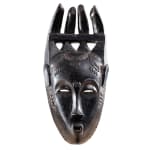Anonymous Baule artist
Portrait Mask (ndoma)
wood
origin: Ivory Coast - early 20th century
origin: Ivory Coast - early 20th century
29 x 11 x 7 cm
11 3/8 x 4 3/8 x 2 3/4 in
11 3/8 x 4 3/8 x 2 3/4 in
custom made metal base included
Photo: Valentin Clavairolles
Sold
Further images
This mask, carved in a hardwood, depicts a woman’s face under four horns, which, in compliance with the dualism typical of Baule culture (starting with the binary opposition of village...
This mask, carved in a hardwood, depicts a woman’s face under four horns, which, in compliance with the dualism typical of Baule culture (starting with the binary opposition of village and wilderness), are no arbitrary adjuncts but signs of a language that extends a being beyond its natural limits. They provide a contrast with the wood’s carefully polished, smooth face and almost metallic appearance and glow. The eyes are barely open, but. It was through these thin openings that the dancer was able to see enough to move with confidence. Beyond its perfection as a carved object, this portrait mask also has the interesting feature of bearing all the facial scarifications that once typified the Baule but no longer exist. Following independence, the government proscribed them in order to eliminate signs of ethnicity and mold the Ivorians into a single people. This exceptional mask is carved with full decorative panoply of curves and counter-curves echoing one another. The Baule are one of the few peoples to have portrait masks appearing at the close of an entertainment dance honoring the person who was supposed to be portrayed and who was present at the event. This type of Baule masks was called ndoma, which means ‘double’. Ndoma were designed as true portraits of real people living in the village and were given their names. However, there was no attempt to depict individual traits. The sculptors made no effort to achieve an accurate likeness. The mask endeavored to provide a transfiguration, rather than identify and individual’s distinguishing features. The main object of these masks was to celebrate an ideal image, from both the aesthetic and moral standpoint and answering to Baule canons of beauty.
Further reading: Boyer (Alain-Michel), “Baule”, Milan, 2008
Further reading: Boyer (Alain-Michel), “Baule”, Milan, 2008
Provenance
Private Collection, Antwerp
let's keep in touch
Join our community & never miss out on a DUENDE moment from now on
* denotes required fields
We will process the personal data you have supplied to communicate with you in accordance with our Privacy Policy. You can unsubscribe or change your preferences at any time by clicking the link in our emails.





